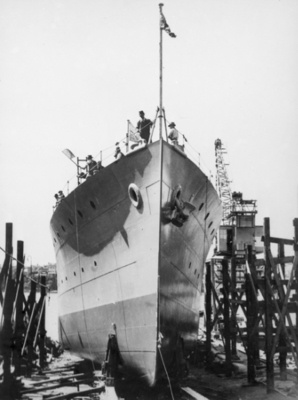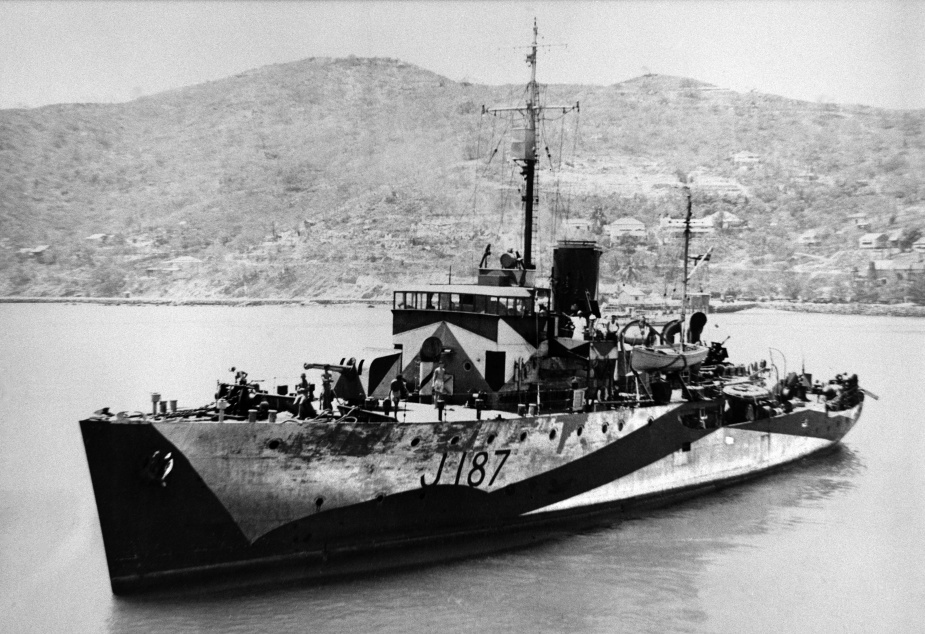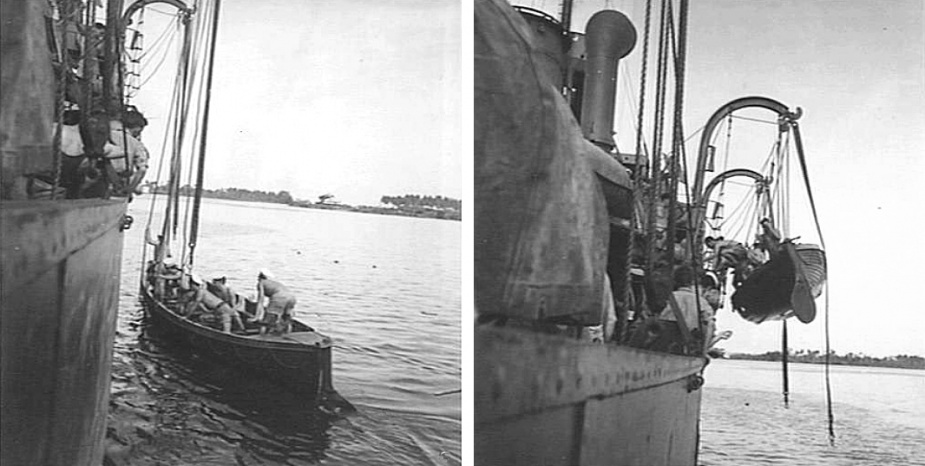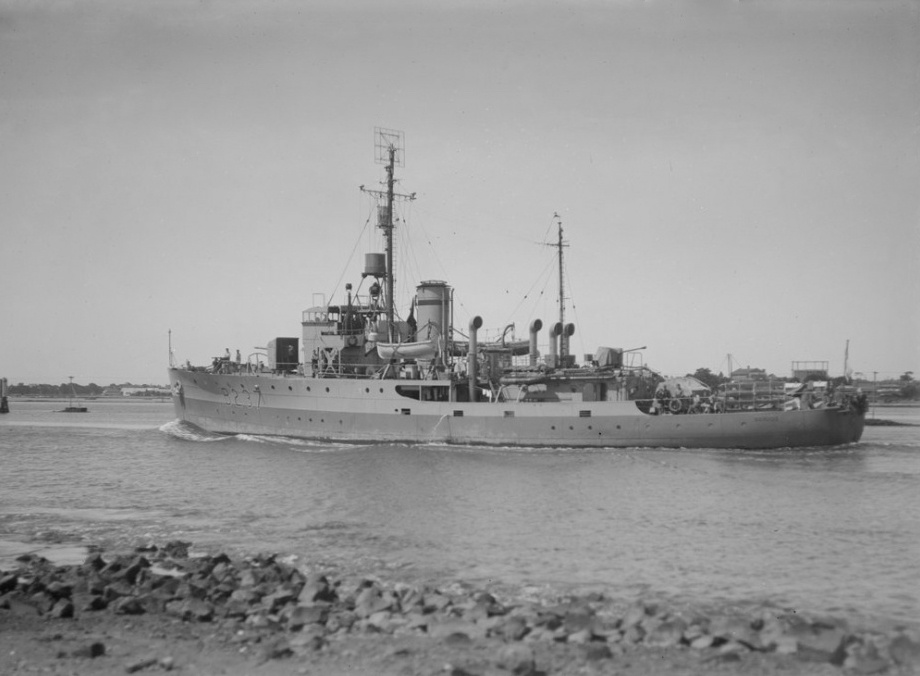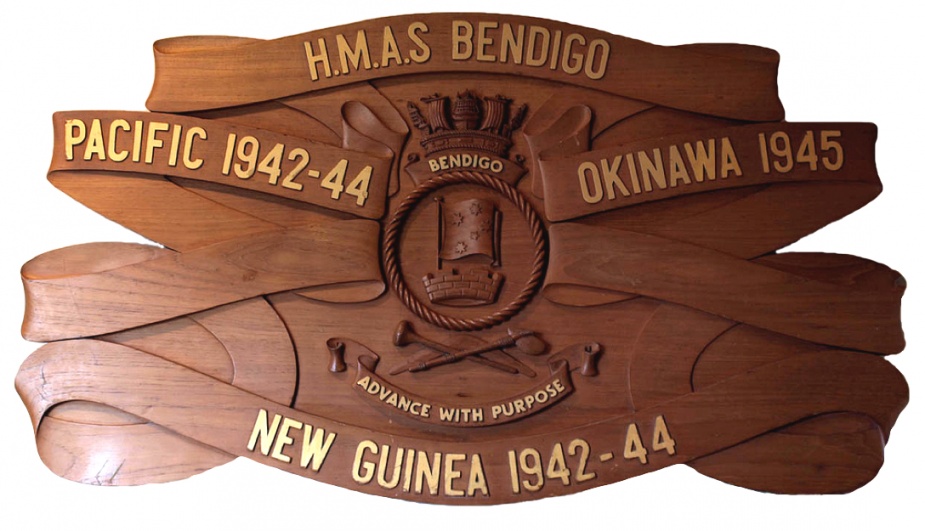HMAS Bendigo (I)
| Class |
Bathurst Class |
|---|---|
| Type |
Australian Minesweeper |
| Role |
|
| Pennant |
J187, B237, A111 |
| Motto |
Advance With Purpose |
| Builder |
Cockatoo Docks and Engineering Co Ltd, Sydney |
| Laid Down |
12 August 1940 |
| Launched |
1 March 1941 |
| Launched by |
Dame Mary Hughes, wife of the Minister for the Navy |
| Commissioned |
10 May 1941 |
| Decommissioned |
27 September 1946 |
| Fate |
Sold to a Chinese company as a civilian vessel, later absorbed into the People's Liberation Army Navy |
| Dimensions & Displacement | |
| Displacement | 590 tonnes (standard) |
| Length | 56.69 metres |
| Beam | 9.45 metres |
| Draught | 2.59 metres |
| Performance | |
| Speed | 15 knots |
| Complement | |
| Crew | 85 |
| Propulsion | |
| Machinery | Triple expansion engine, 2 shafts, 1,750 hp |
| Horsepower | 1750 |
| Armament | |
| Guns |
|
| Other Armament | Depth charge chutes and throwers |
| Awards | |
| Battle Honours | |
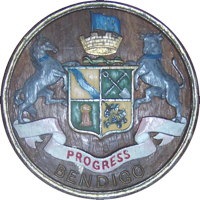
HMAS Bendigo (I) was one of sixty Australian Minesweepers (commonly known as corvettes) built during World War II in Australian shipyards as part of the Commonwealth Government’s wartime shipbuilding programme. Twenty (including Bendigo) were built on Admiralty order but manned and commissioned by the Royal Australian Navy. Thirty six were built for the Royal Australian Navy and four for the Royal Indian Navy.
HMAS Bendigo was laid down at Cockatoo Docks and Engineering Co Ltd, Sydney, NSW on 12 August 1940. She was the first RAN warship to carry the name of the city in Victoria situated 150km north west of the state's capital, Melbourne. She was launched on 1 March 1941 by Dame Mary Hughes, wife of the Minister for the Navy.
Bendigo commissioned at Sydney on 10 May 1941 under the command of Lieutenant Commander James AR Patrick RANR(S).
Bendigo departed Sydney on 4 July 1941 and began her active war career in the Darwin area where she remained for a period of two months. On 22 September she sailed for Singapore to become a unit of the China Squadron. The period remaining before the outbreak of the Pacific War was spent on escort, sweeping and patrol duties in the Singapore area. On 24 November 1941 Bendigo became a unit of the 21st Minesweeping Flotilla (HMA Ships Maryborough (Flotilla Leader), Goulburn, Burnie and Bendigo).
January 1942 saw Bendigo operating out of Singapore on sweeping, escort and patrol duties, down to Berhala and Banka Strait. On 30 January Bendigo anchored in Singapore Roads and remained there until 6 February. During this time the ship experienced 25 alerts and Japanese bombers were over two or three times a day. On 2 February two near misses caused extensive scarring from shrapnel. Bendigo made only one move from her anchorage during this period. On 5 February 78 survivors were taken off the burning Empress of Asia at Sultan Shoal.
On 6 February Bendigo proceeded to No 24 Swept Channel north of Durian Strait, to act as lightship for an outward bound convoy. At 01:00 the following day, her sister ship HMAS Wollongong approached with instructions to proceed in company, as she had Senior Officer, Minesweepers, on board. At daybreak Bendigo landed a party in the vicinity of Abang Besair to search for British airmen. Dense undergrowth forced the abandonment of the search. Subsequent signals informed Bendigo that the original message should have read ‘search for survivors from British Airman’. Rejoining Wollongong, the two minesweepers proceeded to an anchorage off the west coast of Durei Island. At 23:00 Bendigo and Wollongong sailed to rendezvous with three auxiliary minesweepers.
The three auxiliaries were contacted at daybreak on 8 February and all five ships proceeded to Amphitrite Bay. Seventeen Japanese aircraft in one flight were sighted en route. At 15:00 the same day the flotilla sailed for Batavia. During the course of the voyage two of the auxiliary sweepers lost contact in the darkness. Bendigo commenced a search at 01:00 on 9 February. Failing to locate the missing ships, she put into Gambie Bay until 13:50, when an attempt was begun to locate Wollongong. The latter vessel was eventually rejoined at 08:00 the following day (10 February) at Pulo Benu Inlet. The two ships were still missing and had, unknown to Bendigo, proceeded independently for Batavia.
At 06:59 on 11 February 1942 Bendigo and Wollongong entered Palembang Channel, moved up river and anchored off the oil refineries. After fuelling the following day, the minesweepers sailed at 13:40, picked up a convoy at the mouth of the Palembang River and proceeded for Batavia. Banka Strait was cleared by daybreak the following day (13 February).
At 11:17 eight Japanese aircraft circled the ships, and 15 minutes later the planes returned and commenced bombing from approximately 10,000 feet. Ignoring the main convoy, the attacking planes singled out a merchant ship Wuchang which had overtaken the convoy and was then about a mile ahead. Many bombs narrowly missed Wuchang, but she was not hit or damaged. The planes made no attempt to attack the convoy. Bendigo’s Commanding Officer noted ‘they had in fact found a more interesting target in the shape of seven large tankers some 40 miles to the east’.
At 23:00 the convoy anchored 20 miles south-east of North Watcher Head, where they remained until the following morning. At 06:00 the voyage to Batavia continued minus about half the convoy, the masters having elected to remain at anchor for a further period. The balance proceeded with Wollongong and Bendigo until 10:00 hours when the ships dispersed off Edam Island.
Bendigo anchored in Batavia Roads at 12:45 on 14 February 1942 and remained awaiting instructions until 18 February when she moved to the Outer Roads to give anti-submarine protection to incoming ships. On 21 February Wollongong relieved her of this duty and she returned to harbour.
The following day Bendigo fuelled, took on board eight members of the AIF who had escaped from Singapore, and at 14:00 sailed with Burnie to join the Sunda Strait patrol off Merak. Bendigo remained at Merak as part of the Sunda Patrol until the night of 27/28 February, when Sunda Strait was abandoned. The only attack from enemy planes mentioned by Bendigo’s Commanding Officer took place on 27 February. At 15:55 three Japanese Army light bombers commenced dive bombing and machine gunning the anchored ships off Merak. Three separate attacks developed and in all 27 bombs were dropped. An effective anti-aircraft barrage was put up and though the planes attempted to machine gun swimming parties in the water, no hits were scored and there was no damage or casualties.
At daybreak on 28 February Bendigo sailed from Merak in company with her sister ships Maryborough, Toowoomba, Ballarat, Goulburn and Burnie for Tjilatjap. En route Bendigo detached with Burnie to pick up survivors of the Dutch ship Boero. The Fourth Engineer and 14 of the crew were rescued from the beach. At 12:52 on 1 March Bendigo entered Tjilatjap Harbour. Shortly afterwards she was ordered to proceed to sea in company with Burnie to search for the Dutch ship Sloterdijk, which had been reported attacked by a Japanese submarine. Unable to locate the merchant ship Bendigo returned to harbour.
After fuelling and embarking 10 officers from the staff of Commodore John Collins RAN, commanding British and Australian naval forces, one RAF officer, one civilian and five officers and 72 men from HMS Jupiter, Bendigo sailed for Fremantle. One plane of undetermined nationality was sighted the following day, and at 17:20 USS Asheville was overtaken in 10°30'S, 110°10'E. On 3 March at 08:40, the ship was circled by a twin engined plane and at 17:00 Bendigo encountered USS Phoenix. Fremantle was reached on 8 March with a margin of 21 tonnes of fuel and one day’s supply of food.
On her return to Australian waters Bendigo was assigned to escort Australia to New Guinea and coastal convoys, continuing in this role almost without a break until 1944 when convoys ceased. On 8 March 1943 Bendigo rescued 153 survivors from the Dutch ship Jacob, which was sunk by Japanese aircraft off Oro Bay while under escort by Bendigo and Kapunda.
On 11 April 1943 she searched unsuccessfully for a Japanese submarine after the sinking of the Yugoslav ship Recina in convoy off the New South Wales coast with the loss of 32 lives. HMAS Moresby was her companion escorting vessel.
In February 1944 Bendigo began escort and patrol duties in the New Guinea area. She was the first Australian minesweeper to take up escort duties between Milne Bay and Manus. Except for docking periods in Sydney, the remainder of 1944 was spent in New Guinea waters on routine patrols and escort duties.
In March 1945 Bendigo arrived in Philippine waters, becoming part of a Task Unit operating with the British Pacific Fleet, to which she remained attached until the end of hostilities. She participated in the operation for the capture of Okinawa (Operation ICEBERG) between March and May 1945. From September to November 1945, following the end of hostilities, Bendigo operated as a minesweeper in the Hong Kong area. She returned to Williamstown on 20 December 1945.
On 4 February 1946 Bendigo sailed from Melbourne for Sydney, in company with Ballarat. Arriving in Sydney on 6 February, Bendigo reduced to a Care and Maintenance basis. The ship paid off at Sydney on 27 September 1946. Since commissioning she had steamed 280,100 kilometres.
Bendigo was sold as a seagoing vessel on 5 May 1947 to Ta Hing Co (Hong Kong) and was renamed Cheung Hing. She was later acquired by the Navy of the People’s Republic of China, converted from a merchant ship and rearmed for naval service under the name of Loyang.
The 1981-82 edition of Jane’s Fighting Ships showed altered spellings for various Chinese ships, including a change from Loyang to Luoyang. These changes resulted from the introduction by the People’s Republic of the ‘Pin Yin’ system of transliteration. The last entry for Luoyang identified in Jane’s Fighting Ships was in the 1987/88 edition.
Note: This video is hosted on YouTube. Department of Defence users will not be able to view this video on the Defence Protected Network.
This cine film has been placed online as part of the Sea Power Centre - Australia’s ongoing archival digitisation program.
Further reading
- HMAS Bendigo: Corvette, by Members of her Ship's Company.
- Notable Service to the Empire: Australian Corvettes and the British Pacific Fleet, 1944-45, by Hugh Campbell published by Naval Historical Society of Australia Inc, Garden Island, 1995.
- The Corvettes: Forgotten Ships of the Royal Australian Navy, by Iris Nesdale Published by the author, October, 1982.
- Corvettes - Little Ships for Big Men, by Frank B Walker published by Kingfisher Press, NSW, 1996.
- The Australian Centenary History of Defence Volume III, The Royal Australian Navy, edited by David Stevens, Oxford University Press, South Melbourne, Victoria, Australia, 2001.


